Chapter Four Black Zone Process 4.4 Dust Removal System
Release time:
2022-03-22 11:44
Source:
In the lost foam casting process, the molding sand is recycled. The used molding sand needs to be cooled and purified by the sand treatment system before use. In this process, the dust removal system plays an important role in ensuring that the workshop reduces dust pollution and removes fine dust from the molding sand.
First of all, it is necessary to determine the dust source point of the entire production line system (I. e. the place where the dust is generated), determine what kind of dust removal cover and how much air volume is needed according to the dust source, and then connect the corresponding pipeline to the dust collector. How much air volume and power is needed for the fan. The whole dust removal system should not only meet the requirements of dust removal, but also consider the cost of economy.
In short, the dust removal system consists of a dust hood, a dust removal pipeline and a dust collector. The dust removal system of our company has been able to achieve a better dust removal effect. The following takes the equipment of Ruiou as an example to elaborate the dust removal system.
4.4.1 Dust cover
(I)Principles of designing vacuum hoods
1、In the negative pressure surface as much as possible to set up the shielding surface, it is best to cover all, to give a seal. If limited by conditions, can not give sealing, should try to close the vacuum cover dust area.
2、The mouth of the vacuum hood should face the direction of dust diffusion. As far as possible, the source of pollution will be surrounded, or close to the source of pollution.
3、The installation of the dust hood should not affect the operation of the equipment, and should not hinder the operation and maintenance of the equipment. Inspiratory airflow is not allowed to pass through the worker's breathing zone before entering the hood. There should be no obstacles in the flow of the airflow.
4、The suction point should be set at the top of the dust hood, and the volume of the dust hood should be appropriately increased.
5、The location of the suction point should not be located in the material concentration site and the splash area to avoid sucking a large amount of material into the purification system.
6、The axis of the external vacuum hood should coincide with the axis of pollutant emission, and the ratio of the area of the hood opening to the cross-sectional area of the air duct is at most16:1, the length of the horn cover should be 3 times the diameter of the air duct to ensure uniform gas collection at the mouth of the cover. If the uniform gas collection is not achieved, it can be set as multiple gas collection ports or set partition plates and baffles in the gas collection hood.
7、Generally, the size of the hood opening of the gas collecting hood shall not be less than the area of the cross section where the pollutants are diffused.
(II)2. Dust suction cover4 forms: umbrella cover, seam cover, full seal cover, local seal cover, blow suction cover.
The key dust removal points are the operation place of workers and the dust removal of horizontal cooling machine: the dust removal point of the sand falling chamber at the box turning machine, the dust removal point of the rain sand adding device at the box burying model, the dust removal point of the pouring station, and the horizontal cooling machine need a lot of dust removal and air cooling;
In the process of sand treatment, it is necessary to purify the molding sand. There are auxiliary dust removal points: screening and conveying dust removal point, dust removal point at the lifting machine, dust removal point at the belt conveyor, dust removal point at the plow unloader, etc.
1、 Dust cover at the box turning machine
The dust removal cover of the box turning machine uses a local sealing cover, which seals most of the parts. The side of the box turning and the side of the hoisting casting are open. Air volume required here8000~13000m/h, dust removal pipe diameter Φ 400 or Φ 500.
2. Dust cover of rainwater sand-adding device at the shape of buried box
Due to the limited structure, the dust cover of the deluge sand adding device adopts a slit cover, and the dust is sucked into the cover by the movement of the negative pressure airflow outside the cover. The air volume required here is about4500m ³/h, dust removal pipe diameter φ300.
You can also attach my company's patented design, retractable organ-type dust cover, to better ensure that the dust does not escape.
3、Dust cover can be added above the inclined chute pipe of buried box shape
Here, depending on whether it is convenient to operate, choose to add an umbrella cover, and the air volume is about4500m ³/h, dust removal pipe diameter φ300.
4. Dust cover of pouring station
Umbrella cover shall be used for pouring station, and the distance between the upper plane of the sand box and the cover opening1.2 meters, convenient pouring operation. The umbrella cover is above the dust area, and there is a shielding surface below the dust area. Baffles can be added to the hood to reduce the area of the dust suction opening, thereby saving air volume. Taking the practical application of a field pouring dust removal hood in Ruiou as an example. The distance between the upper plane of the sand box and the hood opening is 1.2 m; The area of the suction inlet of the dust removal hood is 0.3 ㎡ (the total size of the hood opening is 0.9 m × 1.45 m, with a partition in the middle, and the effective dust collection area is 0.3 ㎡); The control speed is Vx = 2 m/s. The air volume is about 13000 m/h, and the dust removal pipe diameter is Φ 500.
5. Horizontal cooling machine equipment needs large air volume for cooling and dust removal of molding sand, which has been customized as Φ 500 ventilation pipe; Screening conveyor equipment is also customized as Φ 300 ventilation pipe.
Dust cover at the unloading place of other equipment is similar in form and size. This is illustrated by chute and dust cover at the blanking place of belt hoist.These dust covers are of the sealed cover type and require only a smallExhaust volume, can effectively prevent dust overflow, but also reduceDust CollectorofAir volumeReduced investment.
The air volume required for the dust removal hood at the unloading place is not large, so useThe dust removal pipe of φ100 or φ200 can be satisfied. When the air volume is sufficient, it is recommended to choose a larger pipe diameter.
4.4.2 Design calculation of dust removal pipeline system
(I), gas flow in the pipeline to rely on the energy provided by the fan, resulting in the role of the pressure head. Part of the pressure head is used to overcome the friction pressure loss of the pipeline, and the other part is used to overcome the local resistance of the local components of the pipeline and the dynamic pressure loss of the pipeline outlet.
Flow rate control method is mostly used in pipeline design calculation. The gas flow rate in the pipeline is used as the control factor to calculate the pipe diameter and pressure loss.
In the pipeline, the gas flow rate is high, the pipe cross-section is small, the consumption of materials is small, the manufacturing cost is small, but the system pressure loss is large, the operating cost is high, the pipe wear is large, the gas flow rate is low, the pipe cross-section is large, the consumption of materials is more, the manufacturing cost is more, but the system pressure loss is small, the operating cost is low. In the dust removal system, the flow rate is too low, the dust is easy to deposit and hold up the pipeline, and the selected gas flow rate should be considered comprehensively. Check the Minimum Velocity Table of Dust Gas Contained in Dust Removal System Pipeline. Molding sand, vertical pipe14 m/s, horizontal pipe 17 m/s, take 18 m/s.
The steps to calculate the pipeline are as follows:
1、 Reasonably arrange the pipeline, go deep into the site, and strive to be reasonable after investigation and research.
2、 Draw a diagram, number the pipe sections, and note the length and air volume of the pipe sections.
3、 Determine the wind speed and calculate the pipe section size.
4、 Calculate the pressure loss of each section.
5、 Calculate the total air volume and total resistance, and select the fan according to these two data.
(II)In order to save energy, the air volume regulating valve is attached to the pipeline, which can be closed when some dust removal points are not working.
(III)2. Ash outlet shall be designed for horizontal pipes and other places where ash is easy to accumulate, which shall be sealed at ordinary times and ash shall be cleared regularly.
4.4.3 Selection of dust collector
The types of dust collector are: cyclone dust collector, water shock dust collector, pulse bag dust collector, filter cartridge dust collector, etc.
(I)cyclone dust collector
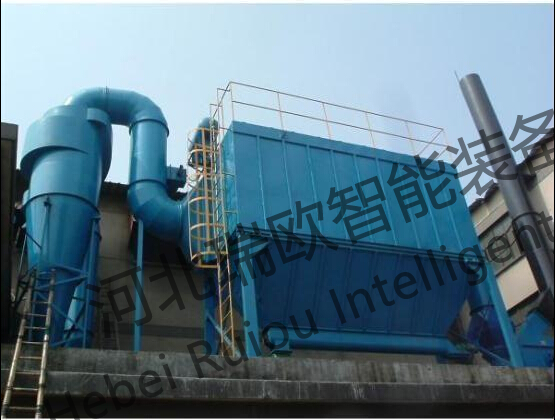
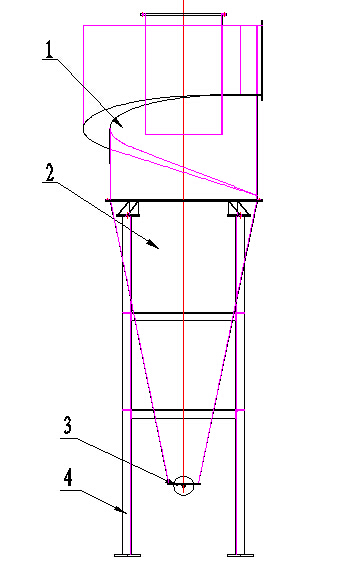
This machine is a vertical dust removal equipment,1 cyclone box, 2 conical box, 3 heavy hammer ash unloading device, 4 bracket and other parts.
After entering the dust collector from the inlet along the tangential direction, the dust-containing airflow rotates from top to bottom along the wall. This rotating downward airflow is called external vortex, which rotates upward along the axis when reaching the bottom of the cone and finally is discharged through the discharge pipe. This upwardly rotating air flow is called an internal vortex. The rotation direction of the inner vortex and the outer vortex are the same. When the dust-containing airflow rotates, the dust particles move to the outer wall under the inertial centrifugal force, and the dust particles reaching the outer wall fall into the ash hopper along the wall under the combined action of airflow and gravity.
1、Main function: generally used for larger particles (>10 m), when the dust concentration is high as a primary treatment. Can be used in series.
2、Equipment advantages:The cyclone dust collector is simple in structure, easy to manufacture, install and maintain management, and the equipment investment and use cost are low. The dust collector has a wide range of applications and can be used for dust and gas treatment in various occasions.
(II)Water shock dust collector
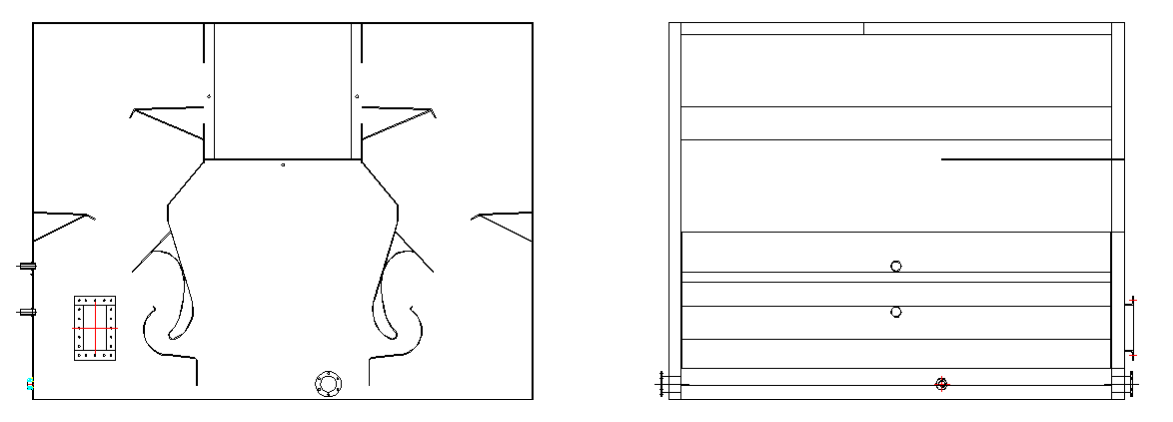

It uses the kinetic energy of the airflow itself to stir up water splashes and disperse the water into fine droplets to capture dust. Dust-laden airflow of water-excited dust collector enters the dust collector from the inlet and rushes down to the water surface, some large particles settle in the water, and the rest of the dust passes through with the airflow.The S-shaped channel moves upward. The high-speed air flow stirs up a lot of water and foam, so that dust particles frequently collide with water droplets and are captured and settled. The airflow containing a certain amount of moisture continues to rise, and the airflow suddenly turns when passing through the water baffle, and the water droplets are separated and fall.
1、 Main function: can be used for dust processing of each node in the production line
2、 Equipment advantages:It can cool the dusty gas and purify the harmful gas at the same time; the dust removal efficiency is high, and the resistance loss is 1.0~1.6K Pa.
(III)pulse bag dust collector
A certain number of hangers are installed in the shell of the dust collector, and the outside of the hanger is covered with a filter bag with an open upper end. When the dust airflow enters the shell from the lower part and rises through the filter bag, the dust is retained on the outer surface of the filter bag, and the gas enters the bag through the mesh on the filter bag and is discharged from the top, so that the air is purified.
Whenever the gas flow passes through the filter bag, the large particles are separated from the gas and fall into the lower part of the dust collector. The finer dust particles will adhere or block in the gap of the fiber, forming a certain thickness of the dust layer, which will reduce the efficiency of dust removal. Now the method of periodic back blowing of compressed air is adopted.
A compressed air nozzle is arranged above the opening of each filter bag, which is controlled by a solenoid valve to blow compressed air into the filter bag regularly and in turn to blow the dust attached to the surface of the filter bag into the dust hopper at the bottom. Since the dust discharge of the filter bag is carried out in groups, it does not affect the daily work of the dust collector.
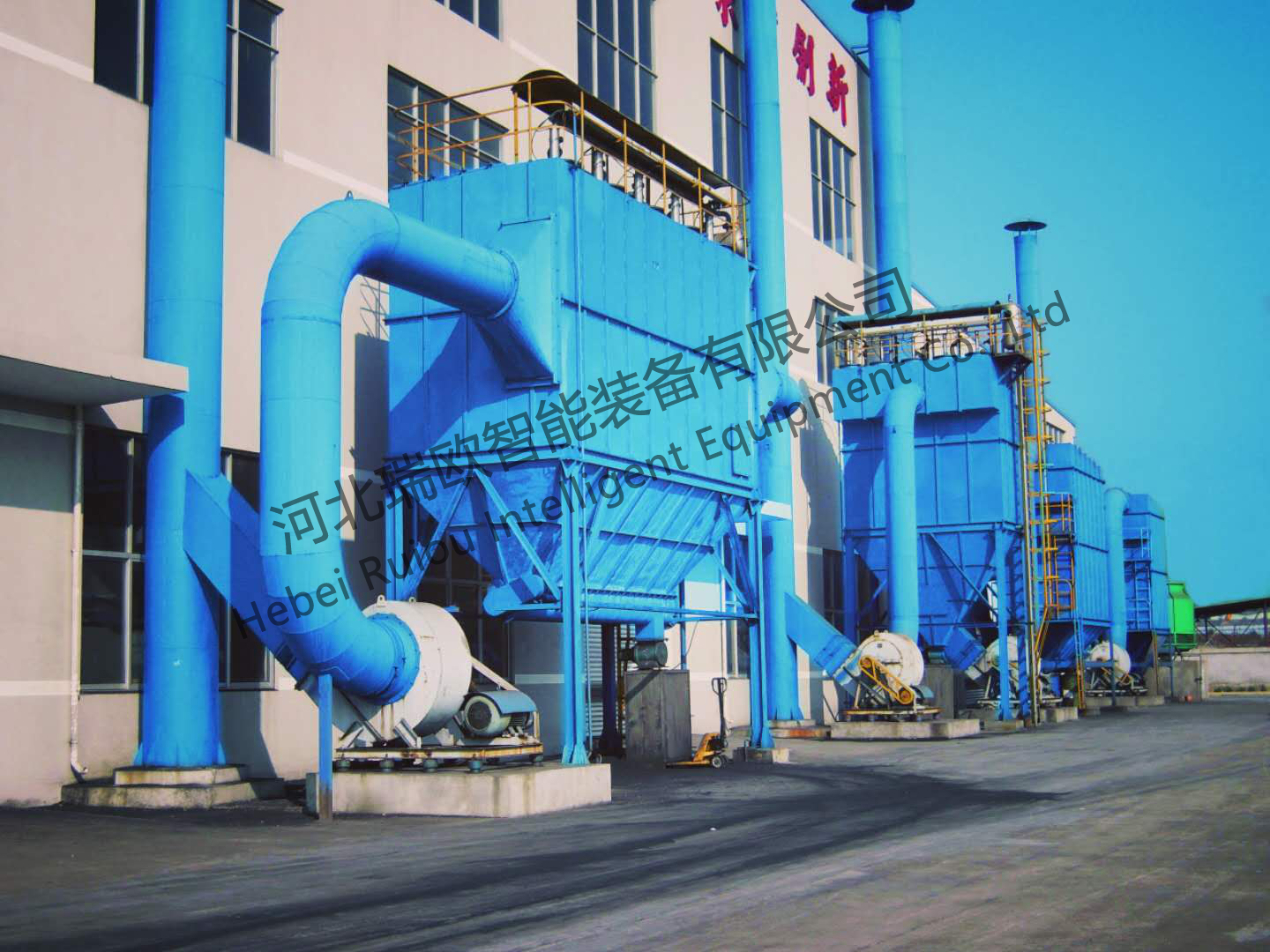
Advantages:
①The air volume range is very wide,Can be customized between 15000~62000 m³/h. The dust removal effect on fine particle dust is significant, and the dust removal efficiency is not affected by flue gas composition, dust concentration, particle dispersion, etc.; the flow rate has little effect on the outlet emission concentration.
②The fine dust capture rate is generally upMore than 99.9, the emission concentration is less than 50mg/m³ or even smaller.
③Structure and maintenance is relatively simple, the general use of sub-room structure, and leave room in the design, so that each sub-room can take turns to repair, does not affect the operation of the equipment.

Principle of pulse jet bag filter
1---Dust collector shell2 --- Air valve 3 ---- Compressed air pipeline
4 --- filter bag5 --- Air lock chamber
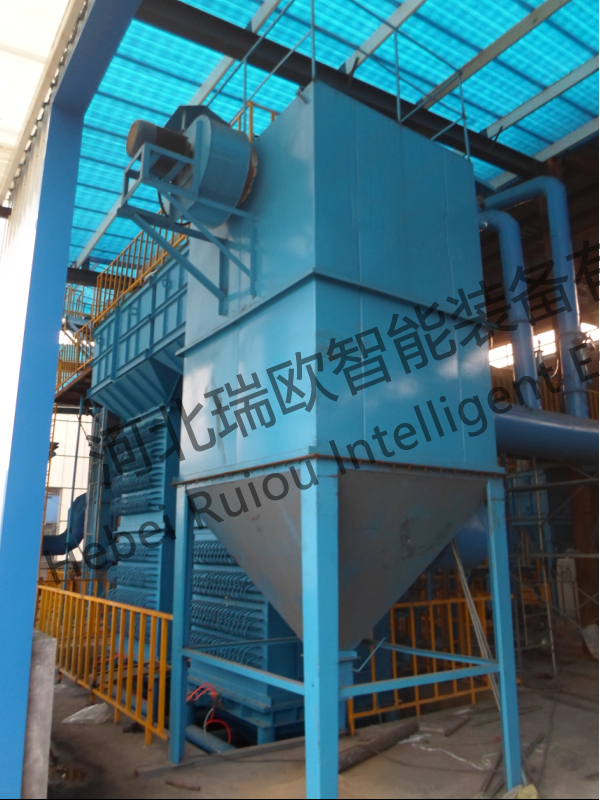

(IV)Cartridge dust collector

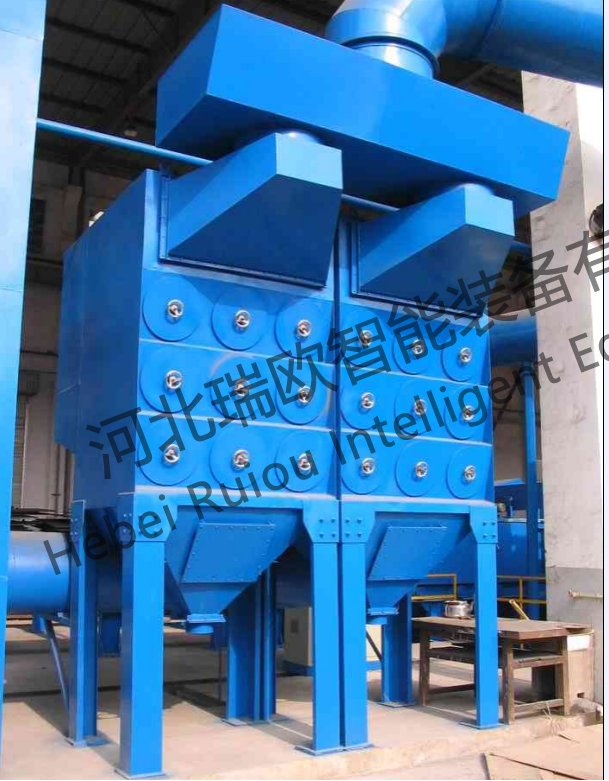
Normal operation Dust removal of filter element 
(Clean Air Outlet;Dust gas inlet; filter chamber; filter cartridge; clean chamber; pulse valve; compressed air inlet; ash hopper)
In the process of dusty gas entering the dust collector from the upper air inlet of the dust collector, the larger particles(100 μm in diameter), which is first settled; smaller particles (0.1-50 μm in diameter) are adsorbed on the surface of the filter cartridge in the air treatment chamber. The purified air passing through the filter cartridge is discharged through the exhaust chamber. When the running resistance of the equipment reaches a certain level, the pulse controller triggers the solenoid valve to open, and compressed air (P = 0.5~0.6Mpa) is blown into the filter cartridge through the blowing pipe, so that dust particles fall off under the action of instantaneous high-pressure airflow, thus reducing the filtering resistance to complete the dust removal and ash removal process (see attached figure).
Through the periodic cleaning of the dust on the surface of the filter cartridge, the running resistance of the equipment is relatively stable, which is an important link to ensure the normal operation of the dust removal system. The settled and cleaned dust is collected in the ash hopper, which is automatically discharged by the ash discharge valve or gathered in the ash bucket, and is manually discharged at regular intervals.
Related News










